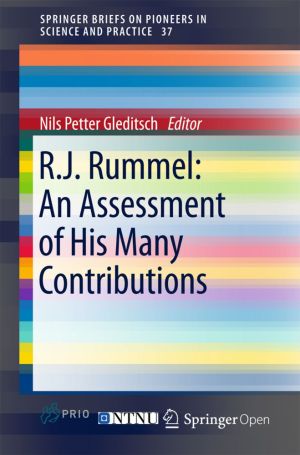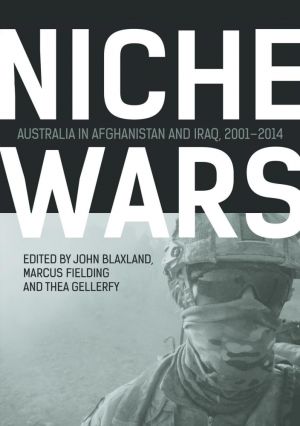Niche Wars
Australia in Afghanistan and Iraq, 2001-2014
by John Blaxland, Marcus Fielding, Thea Gellerfy
DescriptionTable of ContentsDetailsHashtagsReport an issue
Niche Wars examines Australia's experience on military operations in Afghanistan and Iraq from 2001 to 2014. These operations saw over 40 Australian soldiers killed and hundreds wounded. But the toll since has been greater. For Afghanistan and Iraq the costs are hard to measure. Why were these forces deployed? What role did Australia play in shaping the strategy and determining the outcome? How effective were they? Why is so little known about Australia's involvement in these campaigns? What lessons can be learned from this experience?
Niche Wars commences with a scene-setting overview of Australia's military involvement in the Middle East over more than a century. It then draws on unique insights from many angles, across a spectrum of men and women, ranging from key Australian decision makers, practitioners and observers. The book includes a wide range of perspectives in chapters written by federal government ministers, departmental secretaries, service commanders, task force commanders, sailors, soldiers, airmen and women, international aid workers, diplomats, police, journalists, coalition observers and academics.
Niche Wars makes for compelling reading but also stands as a reference work on how and why Australia became entangled in these conflicts that had devastating consequences. If lessons can be learned from history about how Australia uses its military forces, this book is where to find them. 






Book Description
Australia invoked the ANZUS Alliance following the Al Qaeda attacks in the United States on 11 September 2001. But unlike the calls to arms at the onset of the world wars, Australia decided to make only carefully calibrated force contributions in support of the US-led coalition campaigns in Afghanistan and Iraq. Why is this so?Niche Wars examines Australia's experience on military operations in Afghanistan and Iraq from 2001 to 2014. These operations saw over 40 Australian soldiers killed and hundreds wounded. But the toll since has been greater. For Afghanistan and Iraq the costs are hard to measure. Why were these forces deployed? What role did Australia play in shaping the strategy and determining the outcome? How effective were they? Why is so little known about Australia's involvement in these campaigns? What lessons can be learned from this experience?
Niche Wars commences with a scene-setting overview of Australia's military involvement in the Middle East over more than a century. It then draws on unique insights from many angles, across a spectrum of men and women, ranging from key Australian decision makers, practitioners and observers. The book includes a wide range of perspectives in chapters written by federal government ministers, departmental secretaries, service commanders, task force commanders, sailors, soldiers, airmen and women, international aid workers, diplomats, police, journalists, coalition observers and academics.
Niche Wars makes for compelling reading but also stands as a reference work on how and why Australia became entangled in these conflicts that had devastating consequences. If lessons can be learned from history about how Australia uses its military forces, this book is where to find them.
This open book is licensed under a Creative Commons License (CC BY-NC-ND). You can download Niche Wars ebook for free in PDF format (22.5 MB).
Table of Contents
Part 1
Policy and strategy
Chapter 1
A minister's perspective
Chapter 2
A departmental Secretary's perspective
Chapter 3
A Chief of Defence Force's perspective
Part 2
On operations in Afghanistan and Iraq
Chapter 4
Australia's intervention in Afghanistan, 2001-02
Chapter 5
Air Operations Control and Reporting Centre
Chapter 6
Conventional stability operations at the battle group level in Iraq
Chapter 7
Maritime operations
Chapter 8
Embeds
Part 3
Joint forces, enablers and partners
Chapter 9
Command and control
Chapter 10
Intelligence in Afghanistan
Chapter 11
Civil and humanitarian assistance
Chapter 12
The military and the media
Chapter 13
The Australian Federal Police in Afghanistan, 2007-14
Chapter 14
AusAID stabilisation
Chapter 15
The gender dimension
Part 4
Lessons and legacies
Chapter 16
Lessons and legacies of the war in Afghanistan
Chapter 17
American and British experience in Iraq and Afghanistan, 2001-04
Chapter 18
Lessons and legacies of the use of force
Chapter 19
The Official History of Australian Operations in Iraq and Afghanistan, and Australian Peacekeeping Operations in East Timor
Chapter 20
Final reflections
Appendix 1
Australian units and formations deployed to Afghanistan and the Middle East, 2001-14
Appendix 2
Chronology: Australia's military involvement in Afghanistan, 2001-present
Appendix 3
Chronology: Australia's military involvement in Iraq, 2003-09
Book Details
Title
Niche Wars
Subject
History
Publisher
ANU Press
Published
2020
Pages
410
Edition
1
Language
English
ISBN13
9781760464028
ISBN10
1760464023
ISBN13 Digital
9781760464035
ISBN10 Digital
1760464031
PDF Size
22.5 MB
License

Related Books

This book focuses on the origins, consequences and aftermath of the 1995 and 1999 Western military interventions that led to the end of the most recent Balkan wars. Though challenging problems remain in Bosnia, Macedonia, Kosovo, and Serbia, the conflict prevention and state-building efforts thereafter were partly successful as countries of the reg...

This is an open access book. Lewis F Richardson (1981-1953), a physicist by training, was a pioneer in meteorology and peace research and remains a towering presence in both fields. This edited volume reviews his work and assesses its influence in the social sciences, notably his work on arms races and their consequences, mathematical models, the s...

Evolutionary Research in Archaeology seeks to provide a comprehensive overview of contemporary evolutionary research in archaeology. The book will provide a single source for introduction and overview of basic and advanced evolutionary concepts and research programs in archaeology. Content will be organized around four areas of critical research in...

The European Experience brings together the expertise of nearly a hundred historians from eight European universities to internationalise and diversify the study of modern European history, exploring a grand sweep of time from 1500 to 2000. Offering a valuable corrective to the Anglocentric narratives of previous English-language textbooks, scholar...

This free book represents one of the key milestones of DESIGNSCAPES, an H2020 CSA (Coordination and Support Action) research project funded by the European Commission under the Call "User-driven innovation: value creation through design-enabled innovation". The book demonstrates that adopting design allows us to embed innovation within th...

The book provides a critical and constructive assessment of the many contributions to social science and politics made by Professor R. J. Rummel. Rummel was a prolific writer and an important teacher and mentor to a number of people who in turn have made their mark on the profession. His work has always been controversial. But after the end of the ...

